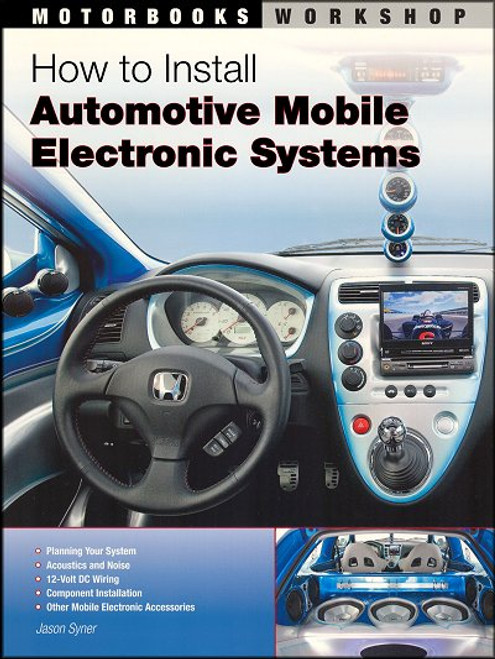For more than 30 years, most cars and trucks have incorporated onboard diagnostics (OBD), which monitor and adjust major automotive systems such as the engine, drivetrain, fuel system and more. And as complex as that technology may sound, in this how-to guide, OBD expert, tuner and author Keith McCord, explains how you can use a hand-held scanner, connected to the the OBD port, to interpret the data. In addition to that basic operation, Keith also explains how to tackle problems so you can trace it back to the source and fix the root cause, not just the symptom. A very comprehensive book covering automotive on-board diagnostics, written for the do-it-yourself mechanic. Note: This manual is a print on demand by the publisher and thus has black and white photos and diagrams. It's harder to get; however, we keep this manual in stock and offer Free and Fast Shipping to our continental US48 customers.
Book Excerpt: Automotive Diagnostic Systems: Understanding OBD-I and OBD-II - Step-by-Step Scan Tool Use FREEZE-FRAME DATA
OXYGEN SENSORS
OXYGEN SENSORS ARE CONSUMABLE
Subject: Transportation: Automotive: On-Board Diagnostics (OBD). Covers OBD-I and OBD-II. DIY manual. ISBN-10: 161325525X | ISBN-13: 9781613255254 | CarTech SA174P
Book Excerpt: Automotive Diagnostic Systems: Understanding OBD-I and OBD-II - Step-by-Step Scan Tool Use FREEZE-FRAME DATA
When the DTC is triggered, Mode $02 specified by SAE J1978 records it. In addition, it stores the sensor data and the calculated data at the time when it was set. At a minimum, the following data points are stored.As discussed earlier, Mode $02 is the same data structure as Mode $01 ("show current data"), except for PID 02. PID 02 is returned in the data stream and adds the trouble code to the sensor/monitored data. Unfortunately, there are data sets that often appear in Mode $01 that are not available in Mode $02, so not all of the sensor/calculated data may be available in the freeze-frame data. Fortunately, the pertinent data helps to lead you to the proper diagnosis. As technology continues to improve, more data is stored in the freeze-frame data set available to you. Some vehicles even store two snap shots before the error occurred: A snapshot of the data right after the error, and then two more snapshots a few seconds after the error occurred.
- DTC that was triggered
- Engine speed registered in RPM
- Engine load that has been calculated by the ECM
- Short-term fuel trim(s)
- Long-term fuel trim(s)
- Intake manifold pressure reading
- Vehicle speed in kilometers per hour
- Coolant temperature
- Fuel System status
OXYGEN SENSORS
To control the fueling system, the ECM bases its fuel calculations on incoming air mass, engine operating conditions, and altitude. To ensure that the ECM?s calculations for fueling are within specification, the entire system runs in closed loop, with the O2 (or "O2" in OBD codes) sensors are located in the exhaust system at positions that give the sensor the optimal reading of the exhaust stream. Vehicles can have multiple O2 sensors located in the exhaust system, but there are two main types of O2 sensors that are based on their location and function. The first O2 sensor type is located before the catalytic converters and is known as the up-stream or pre-cat sensor. Its function is to report to the ECM how close the engine is to running at the ideal air/fuel ratio. Typically, these sensors are placed one per engine bank and are located fairly close to where all the primaries of the exhaust manifold come together. This position gives a good sample of the mixture from all the cylinders. The second O2 sensor type is located after the catalytic converter (down-stream) and is known as the post-cat sensor. Its main function is to evaluate the efficiency of the catalyst and report to ECM. This sensor is purely designed for emissions quality and has no bearing to the ECM?s fuel correction calculations.
OXYGEN SENSORS ARE CONSUMABLE
The oxygen sensor is probably the most important sensor in the entire closed-loop feedback circuit. So if this sensor fails, or is even degraded, the performance, economy, and emissions can suffer greatly. Few people realize that the oxygen sensor, unlike most other sensors, is a consumable item. This means that the oxygen sensor has a limited lifetime of service and is designed to be replaced when it wears out. This is usually the only sensor on the vehicle that is actually a wear item. People ask how often the oxygen sensor should be replaced. I?ve seen oxygen sensors still functioning within specifications after 100,000 miles, and I?ve seen new oxygen sensors fair almost immediately due to other issues with the engine. But, on normally running, common-service engine, I tell people to replace their pre-cat oxygen sensors when they replace their tires, and this means that oxygen sensors typically should be replaced every 35,000 to 50,000 miles. If the vehicle is not driven on a regular basis or is in a severe-duty application, I recommend replacing sensors every 17,500 to 25,000 miles. The replacement cost of a sensor pales in comparison to the amount of fuel mileage lost due to a degraded or bad sensor. Unfortunately, it may take a while before a bad sensor degrades enough to actually have the ECM set a DTC and illuminate the MIL. That equates to a lot of wasted gasoline.
Subject: Transportation: Automotive: On-Board Diagnostics (OBD). Covers OBD-I and OBD-II. DIY manual. ISBN-10: 161325525X | ISBN-13: 9781613255254 | CarTech SA174P
TABLE of CONTENTS:
- Introduction to On-Board Diagnostics (OBD)
- OBD-II Standardization
- The OBD-II Data Interface
- Scan Tool Interfaces
- OBD-II Modes
- Diagnostic Trouble COdes
- Freeze-Frame Data
- Emissions Tests and System Monitors
- Four-Stroke Engine Cycle
- OBD-II and the Otto Engine Model
- Controlling Fuel Systems
- Dynamic Fuel Correction
- Engine Ignition Controls
- Misfires
- Sensors
- Oxygen Sensors
- Glossary
- Using a Volt Ohm Meter
- Generic OBD-II DTC Codes
- Manufacturer-Specific OBD-II DTC Codes










